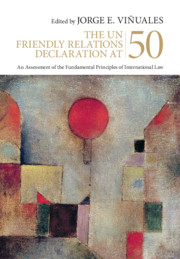 The UN Friendly Relations Declaration at 50
The UN Friendly Relations Declaration at 50 Book contents
- The UN Friendly Relations Declaration at 50
- The UN Friendly Relations Declaration at 50
- Copyright page
- Dedication
- Epigraph
- Contents
- Contributors
- Abbreviations
- Introduction
- 1 The System of the Friendly Relations Declaration
- 2 The Historical Origins and Setting of the Friendly Relations Declaration
- Part I The Principles of the Friendly Relations Declaration
- Part II Fundamental Principles of International Law beyond the Friendly Relations Declaration
- Appendix The Friendly Relations Declaration (also available at www.un-documents.net/a25r2625.htm)
- Index
2 - The Historical Origins and Setting of the Friendly Relations Declaration
Published online by Cambridge University Press: 21 September 2020
- The UN Friendly Relations Declaration at 50
- The UN Friendly Relations Declaration at 50
- Copyright page
- Dedication
- Epigraph
- Contents
- Contributors
- Abbreviations
- Introduction
- 1 The System of the Friendly Relations Declaration
- 2 The Historical Origins and Setting of the Friendly Relations Declaration
- Part I The Principles of the Friendly Relations Declaration
- Part II Fundamental Principles of International Law beyond the Friendly Relations Declaration
- Appendix The Friendly Relations Declaration (also available at www.un-documents.net/a25r2625.htm)
- Index
Summary
The 1970 Friendly Relations Declaration is a peculiar document. This is so even by comparison to the battery of legally non-binding but rhetorically charged and politically resonant General Assembly resolutions with which the non-aligned world created through decolonisation attempted to craft a new international order in the decades after the Second World War. Consisting of seven basic concepts of contemporary international law, the 1970 resolution purports to map the rules, norms and practices that States and international lawyers are willing to recognise as necessary for a real commitment to ‘friendly relations’. It spells out with varying degrees of clarity and specificity a host of propositions, many of which had already found at least partial expression in multilateral treaties, UN resolutions and rules of customary international law prior to October 1970, when the resolution was finally adopted formally. The result is a lengthy and at times unwieldy document cobbled together through a series of complex negotiations – an instrument that is more a patch-and-mend aggregation of bits and pieces of conceptual furniture than it is a crystalline conceptual blueprint for the new world orders envisioned by the greater and lesser powers of the 1960s.
- Type
- Chapter
- Information
- The UN Friendly Relations Declaration at 50An Assessment of the Fundamental Principles of International Law, pp. 23 - 48Publisher: Cambridge University PressPrint publication year: 2020


